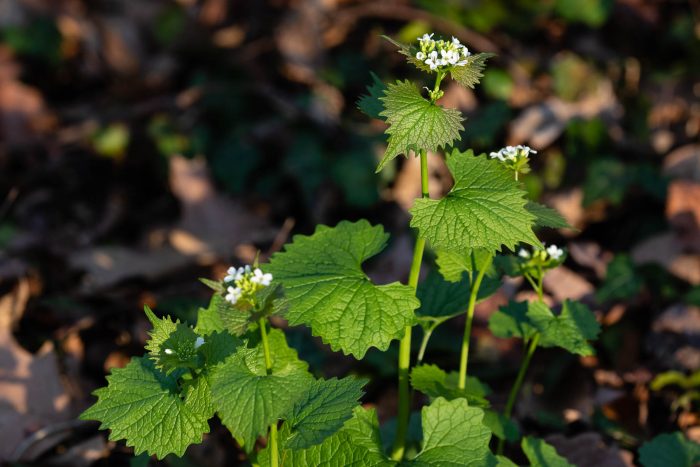Garlic Mustard
Alliaria petiolata
Garlic mustard is an invasive plant that can be found in woods.
This section shows one large critter image at a time. Use the thumbnails that follow to select a specific image to display here.

This gallery contains a grid of small thumbnails. Selecting a thumbnail will change the main image in the preceding section.
Appearance
Garlic mustard goes through two growth stages. In its first year, it grows dark-green leaves in a rosette pattern. The eaves are about five inches in length and kidney shaped with scalloped edges. In its second year, the leaves will be triangular shaped with more distinct teeth on the edges. The plant can grow up to three feet tall in its second year. It will also develop white flowers with four white petals.
Predators
Deer and woodchucks will eat garlic mustard, but not at a degree that will control the spread of garlic mustard.
Reproduction and life cycle
Garlic mustard plants sprout in early spring. Garlic mustard is a biennial plant so it takes two years to fully mature and produce seeds. The plant will only grow leaves in its first year and then grow flowers and seeds in its second year. The plants flower in April, develop seeds in May and die by June. The seeds grow in pods on branched stems. They are green when they develop but become brown and brittle as the plant dies. The seeds can germinate the next year but can also stay viable for up to five years.
Did you know?
- Garlic mustard was brought to North America from Europe in the 1800s. It is now spreading across North America at a rate of 2,500 square miles per year.
- Garlic mustard is an allelopathic plant which means it produces chemicals that can inhibit the growth of other plants. This means that in addition to outcompeting native plants for resources like sunlight and water, it can also prevent their growth with the compounds it creates.
- Garlic mustard gets its name from the garlic-like smell produced by the leaves when they are crushed. It is also known by the names poor man’s mustard, hedge garlic, garlic root, jack-by-the-hedge, garlicwort and mustard root.
Sources and additional information
- The Nature Conservancy - Garlic Mustard: Invasive, Destructive, Edible
- USDA - Garlic Mustard
- New York Invasive Species Information - Garlic Mustard
